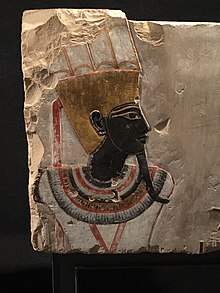Min (god)
| Min | |
|---|---|
Qift, Akhmim | |
| Symbol | the lettuce, the phallus, the bull, the belemnite |
| Parents | Isis |
| Consort | Iabet Repyt Isis |
| Equivalents | |
| Greek equivalent | Pan, Priapus |
Min (Egyptian mnw
Myths and function
| Part of a series on |
| Ancient Egyptian religion |
|---|
 |
|
|

Min's

His importance grew in the Middle Kingdom when he became even more closely linked with Horus as the deity Min-Horus. By the New Kingdom he was also fused with Amun in the form of Min-Amun, who was also the serpent Irta, a kamutef (the "bull of his mother" - a god who fathers himself with his own mother[6]). Min as an independent deity was also a kamutef of Isis. One of Isis's many places of cult throughout the valley was at Min's temple in Koptos as his divine wife.[7] Min's shrine was crowned with a pair of bull horns.[5]
As the central deity of fertility and possibly orgiastic rites, Min became identified by the Greeks with the god


Male deities as vehicles for fertility and potency rose to prevalence at the emergence of widespread agriculture. Male Egyptians would work in agriculture, making bountiful harvests a male-centered occasion. Thus, male gods of virility such as
Cult and worship in the predynastic period surrounding a fertility god was based upon the fetish of fossilized
Civilians who were not able to formally practice the cult of Min paid homage to the god as sterility was an unfavorable condition looked upon with sorrow. Concubine figurines, ithyphallic statuettes, and ex-voto phalluses were placed at entrances to the houses of Deir el-Medina to honor the god in hopes of curing the disability.[9] Egyptian women would touch the penises of statues of Min in hopes of pregnancy, a practice still continued today.[9]
Appearance
In
Family
In Hymn to Min it is said:
Min, Lord of the Processions, God of the High Plumes, Son of Osiris and Isis, Venerated in Ipu...
Min's wives were Iabet and Repyt (Repit).
Isis is the mother of Min as well as his wife.[14]
Ejaculation legend
There have been controversial suggestions, by authors such as British journalist Jonathan Margolis, that the pharaoh was expected to demonstrate, as part of a Min festival, that he could ejaculate—and thus ensure the annual flooding of the Nile.[15] No hard evidence of this exists, according to Egyptologists Kara Cooney, professor of ancient Egyptian art and architecture at UCLA, and her colleague Jonathan Winnerman. This myth may have originated from a misinterpretation of a different festival.[16]
See also
References
- ISBN 978-1-107-66328-2.
- ^ a b "Min". Encyclopædia Britannica. Encyclopædia Britannica Online. 2008. Retrieved 2008-03-27.
- ^ Wilkinson, Richard H. (2003). The Complete Gods and Goddesses of Ancient Egypt. Thames & Hudson. p. 116
- OCLC 748941784.
- ^ ISBN 978-0-226-26011-2.
- ^ Wilkinson, Richard H. (2003). The Complete Gods and Goddesses of Ancient Egypt. London: Thames & Hudson. p. 93. Retrieved 9 October 2022.
- ^ OCLC 845667204.
- )
- ^ OCLC 51647593.
- ^ "Festivals in the ancient Egyptian calendar". University College London. Retrieved 2017-05-15.
- ISBN 978-1-134-62552-9.
- ISBN 978-1-119-97995-1.
- ISBN 978-1-4408-5513-9.
- ISBN 978-0-89236-796-2.
- ^ O : the intimate history of the orgasm (2004) by Margolis, Jonathan, p. 134. He seems to be based on an earlier collection of unusual sex practices.
- ^ "Egyptian pharaohs didn't masturbate into Nile".
Further reading
- McFarlane, Ann. (1995). The God Min to the End of the Old Kingdom. Australian Center for Egyptology. ISBN 9780856686788.
External links
- Site on Min, with some pictures Archived 2015-01-20 at the Wayback Machine
